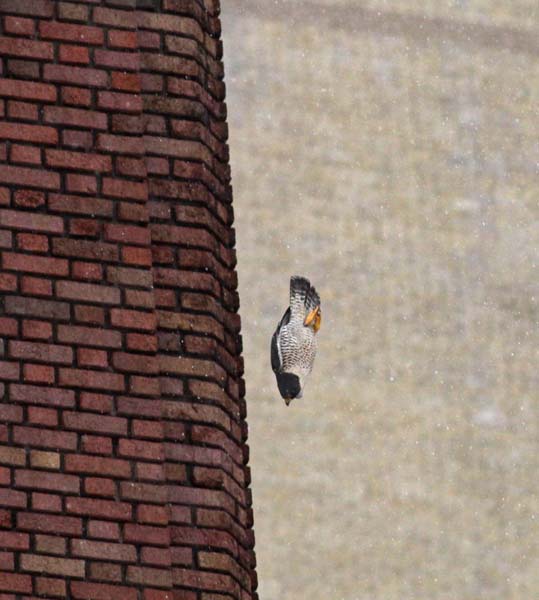FALCON FLASH
Dateline: Cleveland, Ohio
April 7, 2015
Click here to read what happened earlier
Peregrine falcons are fierce predators, and their prey is other birds. One of the main reasons they have moved into cities is because there are so many birds available to hunt year-round. Peregrines dive for their food, a method that allows them to achieve great speed. A straight-down dive with wings folded to the sides is called a "stoop", and speed may reach 200 miles per hour (320 km/h) or more. This is a peregrine in a stoop.
Mr. Harvey Webster, Director of Wildlife Resources at the Cleveland Museum of Natural History, tells us, “Now comes the waiting game and guessing on hatch dates. Peregrine Falcon eggs take 31.5 days of active incubation before pipping and anywhere from 24 to 48 hours from pip to hatch. So the average from onset
of incubation to hatch is 33 days…. However, active incubation often commences with the appearance of the second egg.” You can do the math and figure out approximately when the first chick will hatch.
Nest monitor, Mrs. Saladin, has been very careful not to scare Newton, who is afraid of any human activity coming from inside the skyscraper window, and so Mrs. S made a “blind” out of cardboard. She placed it into the window frame to block out everything but the camera lens from Newton’s view. Even so, Newton was nervous while Mrs. S put the blind in place. Here is what it looks like:
Boomer has been a great dad by bringing food to the nestsite for Newton.
Here is a description of a stoop from an eyewitness who works in an office near the nestsite: "Saw the male in a stoop. He went past my office window in an absolute vertical dive at a speed that startled me. It occurred at a moment (split second) that I happened to be glancing out the window at the lake. He missed his intended target, which I never saw, and flew to the top of the Marion Bldg. on West 3rd. Street…….. I can only say that this bird's speed was incredible---like a bullet shot!!! I know their speed is estimated to be approximately
200MPH--but to actually see it is an incredible experience."
Mr. Scott Wright, who monitored this nestsite for many years, adds: "Actually, the speed is more like 250mph! I had a radar gun lent to me by MPH, (a company in Kentucky that makes radar guns for the police) and I had the gun for two years. I had Szell (an earlier male peregrine falcon at this nestsite) at over 250mph."
The falcon uses its talons to strike and/or grasp the prey in flight, and the impact is usually strong enough to kill the prey instantly. After the prey has been struck (people who have witnessed a strike say it looks like an explosion of feathers) the peregrine must catch the prey as it falls. If the prey is not dead, peregrines will
bite the neck of the victim to finish it off, and they have a special notch in their beak for this purpose.
First there was one egg…………
And right on schedule Newton laid eggs number 3 and 4 …...
The following National Geographic clip shows incredible footage of a peregrine named Frightful as she flies and dives:
Now we watch and wait to see if any or all the eggs will hatch. Keep your eyes and browser set to: http://www.falconcam-cmnh.org/news.php
The blind allowed Mrs. S to get some good pictures without scaring Newton. The following picture shows Newton starting a double-wing stretch...... Mrs. Saladin tells us “…. you can see some of the mixture of colors on her wings. Subtle differences may have to do with some molting (old feathers looking more
brownish), but there is also some color variation in the patterned plumage of individual birds...”
Two days later, Newton laid egg number 2…………..
Our thanks to the Cleveland Museum of Natural History for sponsoring the FalconCams and for the stills.
Photo of a peregrine’s notched beak is courtesy of former nest monitor Mr. Scott Wright. Other photos are courtesy of nest monitors Mr. and Mrs. Saladin.
Click here to read what happened next








